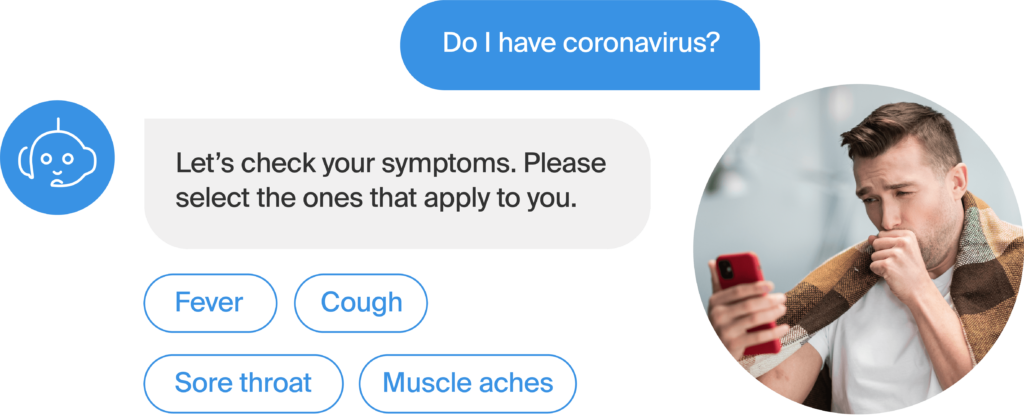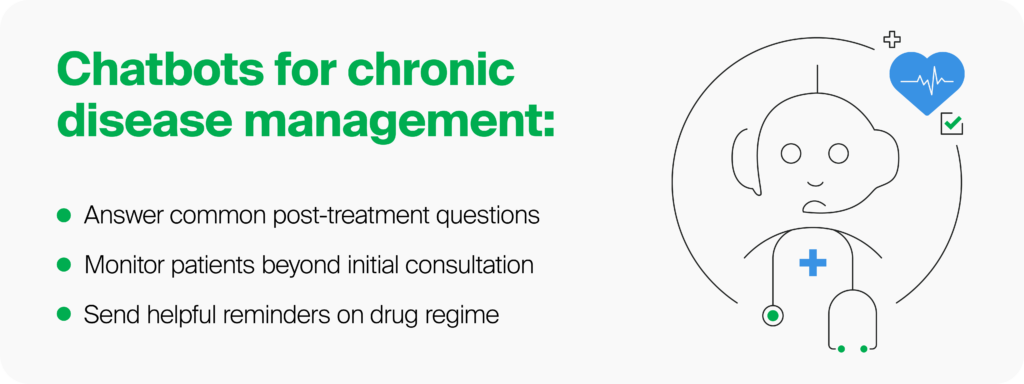AI Chatbots in healthcare are helping sector leaders achieve what’s known as the “Quadruple Aim” of enhancing patient experience, reducing costs, improving health outcomes, and augmenting the clinician experience. Around 40% of healthcare executives believe that Artificial Intelligence (AI) is the technology that will have the greatest impact on their organisations. Patients are also optimistic about the expanding role of AI in healthcare, with a recent Yale Cancer Center study of 926 patients revealing that 55.4% believed artificial intelligence would improve the sector. As AI chatbots become more sophisticated and intelligent, their use cases in healthcare are increasing.
Read on to discover 5 powerful healthcare chatbot use cases, including how conversational AI is a game-changer for appointment scheduling workflows, and how chatbots can successfully support patients with mental health challenges. These examples give invaluable insight into why the global healthcare chatbot market is projected to grow from USD 122 million in 2018 to USD 314.3 million this year (2023).
1. Optimising Appointment Scheduling Workflows

One of the most common use cases for AI chatbots in healthcare is to schedule patient appointments and send reminders to reduce cancellations and forgotten appointments. A no-show can cost a physician $200 per slot on average, but AI solutions such as chatbots can save the healthcare industry $150 billion a year by optimising scheduling workflows. Missed appointments are not just costly and inconvenient for doctors, they can also be a danger to the health of a patient who doesn’t attend. Not only could it be a missed opportunity to diagnose and treat an illness early, but also, research shows that patients who fail to keep one appointment are 70% more likely not to return within 18 months.
To help ensure patients attend an appointment with their primary care-giver, AI chatbots can:
- Enable self-service appointment booking
- Scan the physician or dentist’s schedule to find a time slot that suits the patient
- Help patients cancel and reschedule appointments
- Book a series of ongoing appointments to facilitate a long-term treatment plan
- Send a patient timely reminders and updates
- Ensure a patient has essential information about how to prepare for an appointment so it isn’t wasted. For example, reminding them not to eat for 8-10 hours before a blood glucose test for diabetes.
According to the American Hospital Association, 3.6 million people forego medical care each year due to transportation difficulties. To help resolve this issue, AI chatbots can offer symptom checking, diagnosis, chronic disease management and other services virtually. When a missed appointment is unavoidable, AI chatbots can reach out to waitlisted patients based on priority, likelihood to respond and availability, backfilling the appointment slots. According to Forrester, in addition to saving time and money and increasing productivity, this can reduce the 20.6 day average wait to see a physician by 25%.

2. Symptom Checking, Diagnosis & Triage
Another common use of conversational AI chatbots in healthcare is to ask pertinent questions to help patients identify and describe their symptoms. The chatbot can be programmed to provide an initial diagnosis, triage and escalate to a physician where necessary, and give the patient advice on how to monitor or manage their symptoms. It does this by using speech recognition and Natural Language Processing (NLP) to check the patient’s symptoms against a digital database of diseases and determine which one aligns with the ailments the patient is describing. After this initial assessment, the patient can also request a consultation with a GP.
Healthcare professionals can analyse the chatbot data over time to enable predictive and proactive care, as well as to identify, prevent and quickly treat patients. Some patients will doubtless like the anonymity and find it much easier to talk to a chatbot than a fellow human, particularly if they have a complaint that they may find embarrassing to talk about, such as an STD. A recent medical research study showed that 70% of people between the ages of 18 and 39, and 51% aged between 55 and 69, would be happy to use a symptom checker chatbot.
3. Chronic disease management

Patients with chronic diseases can learn how to manage them better through interacting with a chatbot programmed to understand their illness, symptoms and requirements. For example, patients on post cancer treatment can ask the chatbot questions around a permissible diet, optimal exercise routines and other factors to aid their recovery and ensure they aren’t doing something wrong.
A recent medical experiment pitted a chatbot against a human physician, with each one answering questions and advising half of a group of 142 female breast cancer patients on best practices. The patients scored the interactions, and anything over 3 was counted as a successful conversation. The chatbot scored a 69% success rate and the physicians scored a 64% success rate so the “binomial test showed the noninferiority of the chatbot’s answers”. The use of chatbots to answer these standard questions common to all breast cancer patients, frees doctors up to treat patients who are pre-diagnosis or pre-treatment, and require more urgent care. A similar medical study conducted with patients of inflammatory bowel disease (IBD), concluded that AI chatbots are capable of monitoring patients far beyond initial consultation and educating them in a way that will improve their clinical outcomes.
Chatbots can also send helpful reminders to chronically ill patients to take their pills at the right time of day. This is particularly useful if the patient is forgetful, or has an especially complex drug regime. They can also be set up to track a patient’s weight, heart rate and other critical health factors, as well as to remind and encourage them to keep working towards their health goals. If a patient’s vitals aren’t good, the chatbot can suggest they book an appointment and show them a map of the GPs within a given radius of their location.
4. Mental Health Support
According to a study published by the Journal of Clinical Psychiatry, patients who are suffering from mental health challenges are more likely to commit suicide at night, between midnight and 4am, than during the day. Chatbots are available 24/7 and patients can maintain a certain anonymity during a real time mental health counselling session with them, making this a great use case for conversational AI. The chatbot can ask the patient how they are feeling, or offer a menu of options like “anxious” or “depressed”, and numeric values to denote intensity, for those who find it hard to articulate their emotions. The bot can then offer personalised advice based on the patient’s answers and medical history.
For non-emergency situations a mental health chatbot can provide meditation and affirmation techniques. Chatbots for a psychiatric practice can be trained in basic CBT techniques to aid with short and long term mental health recovery. If appropriate for the types of practice, the chatbot can even be used to connect and grow a community of peers to support one another. According to the American Psychiatric Association 44% of people who engage with a chatbot for mental health advice do so exclusively, and do not feel the need to see a human therapist!
5. Language Translation and Interpretation
Language barrier issues are responsible for reducing the productivity of UK healthcare workers by half a working day every week and more than 33% of healthcare workers say lack of a common language makes it very difficult to assess a patient’s needs. Misunderstandings can be extremely dangerous if a patient leaves a consultation not knowing their diagnosis or prognosis, or being unsure about the next steps, or how to take their prescription. AI chatbots by GMS have multilingual functionality enabling them to understand and assist patients from all over the world. This saves money and time as it removes the need to find an interpreter, plus the chatbot can serve multiple patients in multiple languages at the same time.
What’s Next for Chatbots in Healthcare?
It is still fairly early days for chatbots in the healthcare sector, although the Covid 19 pandemic accelerated their usage considerably. Going forward, their role is expected to extend further. For example, Accenture found that around 31% of virtual appointments were integrated with Electronic Health Records (EHRs) in 2021 and this trend is growing. The wearable medical device market is expected to grow from USD 18.4 billion in 2018 to USD 67.2 billion by 2025, at a CAGR of 18.4%. This growth is expected to drive up the adoption of chatbots integrated with these wearables. Both of these trends mean that chatbots will be able to monitor patient health in real-time and deliver hyper-personalised mental and physical health programs to aid recovery, while freeing up medical professionals to deal with the most complex and urgent health challenges.

